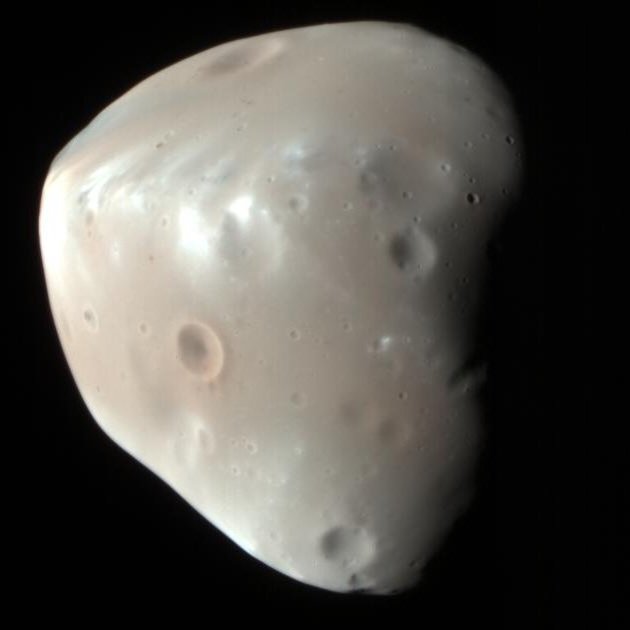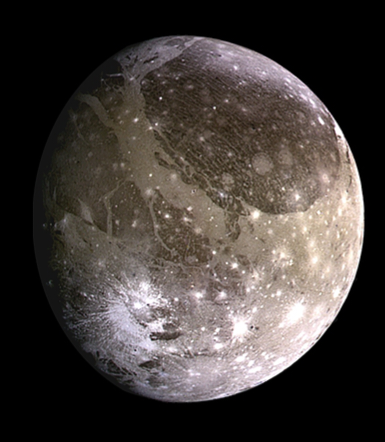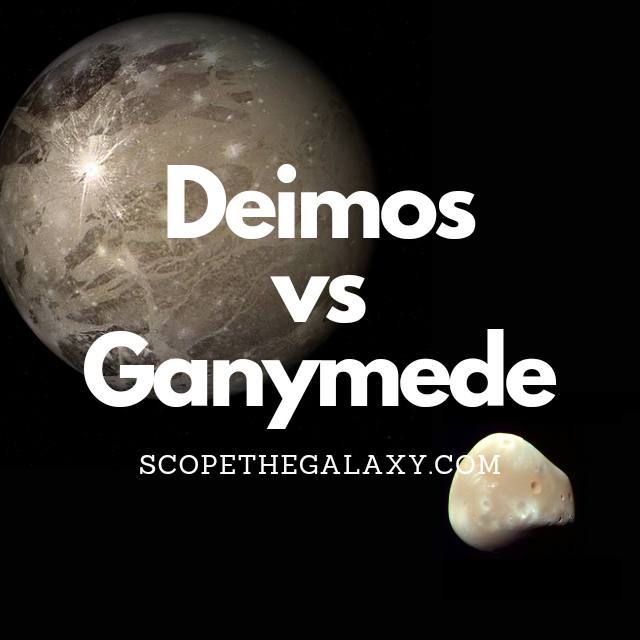*This post may contain affiliate links. This means we may make a commission if you purchase an item using one of our links*
The main differences between Phobos and Ganymede are that Ganymede is the largest moon with a diameter of 5,268km while Deimos is one of the smallest with a diameter of 12.4km, Ganymede has a magnetosphere while Deimos does not and Ganymede orbits Jupiter while Deimos orbits Mars.
There are various other differences between these two so, continue reading if you want a more thorough breakdown of their similarities and differences below.
What Is The Moon Deimos?
Table of Contents

Deimos is the smaller and outermost of the two moons of Mars, named after the Greek God of dread and terror (the brother of Phobos). This satellite was also discovered by American astronomer Asaph Hall just five days before Phobos (12th August 1877).
Scientists like Johannes Kepler had put forward theories for the existence of these moons many years before they were discovered. Their calculations were based on the fact that the planets on either side (Earth and Jupiter) possessed one and four moons, respectively.
Still, none were discovered until the 19th century. One of the main reasons for this is that the tiny size of Phobos and Deimos, combined with an exceptionally close orbit to their planet, means that the glare of Mars often obscures our view of them.
Phobos measures just 15 x 12 x 11 km and completes an orbit of Mars once every 30 hours.
This tiny moon is also a heavily cratered landscape shaped by the impact of asteroid collisions over time. However, the material thrown up from these impacts doesn’t appear to have landed back on the moon’s surface as it usually would. This could be because the lack of gravity on Phobos allowed the ejected material into space.
The surface gravity on Deimos is just 0.003 m/s^2 (compared to 9.807 m/s^2 on Earth), which means the average gravitational pull of Deimos is only 0.003 m/s. With only 1/2500th of Earth’s gravity, you would need a tether to walk on this rocky moon, or every step would put you at risk of achieving escape velocity and launching yourself into space.
The composition of Deimos is similar to Phobos, suggesting that it might also be a captured asteroid. Its surface is very dark gray and has an albedo of around 0.07, meaning it reflects just 7% light (about half of the light Earth’s moon can reflect).
What Is The Moon Ganymede?

Ganymede is the largest of the Galilean moons – and the largest moon in our entire solar system – first discovered on 7th January 1610. The surface of this icy world is frozen and covered by two main types of landscape: young, light regions and old, crater-filled terrain. And these darker areas seem to contain a number of organic materials.
Using the Hubble Space Telescope, astronomers have found evidence of an oxygen-based atmosphere. Still, it is far too thin to support any living organisms that we know of. Based on this, it’s unlikely that Ganymede hosts life as we know it.
Estimates place Ganymede at around 4.5 billion years old (the same age as its planet, Jupiter), and its average distance from the Sun is approximately 778 million km.
Its diameter is 5,268km, making it larger than the planet Mercury. Despite this, Ganymede only possesses half the mass of Mercury at 1.48 × 10^23kg, so it is still classified as a low-density object.
Ganymede takes seven days to orbit its planet at an average distance of 665,00km, and the temperature varies from minus 112 to minus 193 degrees Celsius. In regards to the moon’s core temperature, that would be around 1,226 – 1,446 degrees Celsius.
Among the fascinating features of this ice moon is its magnetosphere. While many planets possess a magnetosphere, no other moon in our solar system shares this trait.
Measuring the changes in the magnetic fields of Ganymede and Jupiter allowed scientists to predict that salt water lies beneath the surface of this freezing world.
However, this is insufficient to support life when you factor in the other elements of this giant moon. In contrast to Europa, the rocky layer of Ganymede is not directly below the ocean, so life would have a difficult time forming both above and below the ice.
In addition, the thick layer of ice on the moon’s surface would make internal, water-based life challenging for scientists to detect.
Similarities Between Deimos And Ganymede
As both are natural satellites, Deimos and Ganymede do share a few similarities, which includes the following:
- Both have a rocky, terrestrial surface.
- Neither have rings surrounding them.
- Both are tidally locked to their planet.
- Both orbit their planet in an elliptical pattern.
- Neither have tectonic plates.
- Ganymede and Phobos have a practically non-existent axial tilt.
Differences Between Deimos And Ganymede
As for the differences between the two, they include the below.
- Deimos orbits Mars whilst Ganymede orbits Jupiter.
- Ganymede is a spherical shape while Deimos is not.
- Ganymede has a diameter of 5,268km whilst Deimos has a diameter of 12.4km.
- Deimos has no atmosphere whilst Ganymede has a very thing atmosphere composed of oxygen.
- A day on Deimos takes 30 hours whilst a Ganymede day takes 7 days 3 hours.
- It takes Deimos 30 hours to orbit Mars and around the Sun in 687 days whilst Ganymede orbits Jupiter in 7 days and 3 hours whilst it orbits the Sun in 12 years.
- Deimos’ temperature ranges between -4 to -112 degrees Celsius whilst Ganymede’s is between -112 and -193 degrees Celsius.
- Ganymede’s density is 1.94 g/cm³ whilst Deimos’ density is 1.47 g/cm³.
- Ganymede’s mass is 1.48 × 10^23 kg whilst Deimos’ mass is 1.4762 × 10^15 kg.
- Deimos’ gravitational strength is 0.003 m/s² whilst Ganymede’s is 1.428 m/s².
- Ganymede orbits Jupiter at an average distance of 665,000km whilst Deimos is 24,680km away from Mars.
- Ganymede has a central core while Deimos does not.
- Ganymede has a magnetosphere while Deimos does not.
Summary
Despite the fact both are one of multiple moons that orbit their respective planets, Ganymede and Deimos are still significantly different in their overall stature when compared to one another.
Whether it be in regards to size, shape, their mass, magnetic field activity among other factors. Ultimately Ganymede and Deimos are very easy to tell apart and function uniquely form one another.

